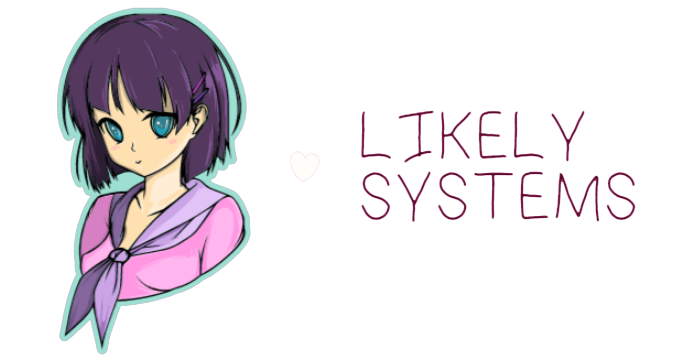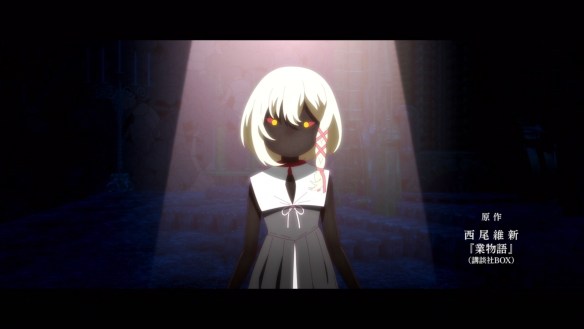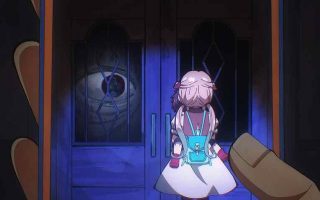Hello folks, and welcome back to Wrong Every Time. Today we are returning to the supplementary trials of Monogatari’s mixed-up heroes, and likely getting into some sort of ornate Shinobu-related fiasco. It is little surprise that the show’s formal conclusion has resulted in all these dangling loose ends – after all, as Monogatari has always emphasized, becoming our best selves is the work of a lifetime. It was actually Sodachi’s first appearance that prompted Araragi to reflect on how “happiness isn’t a race,” and Sodachi returned to reiterate that truth last arc, offering Nadeko the world-weary assurance that nothing ever ends, we just keep working on ourselves and putting one foot in front of the other.
It is up to us whether we find that truth sobering or liberating – whether we lament the endless task of self-definition, or find hope in always having a second chance. But if Monogatari is anything to go by, we should take heart in how changeable our identities truly are, the miraculous fact that merely by dedicating ourselves to new daily practices, we can actually shift our fundamental nature. That we are works in progress will always be a source of anxiety, because it means we are never truly “perfect,” never done with our psychological odyssey. But that great adventure is both the trial and privilege of consciousness; the very fact that we can examine and even change ourselves is the great gift of human nature. Let’s revel in that gift once more, as we return to Monogatari!
Episode 7
Given this arc’s titles refer to Shinobu as “Acerola,” we’re presumably continuing with the tales of Shinobu’s prior life. Whether we’re thinking in terms of Monogatari’s psychological dimensions or its fantastical ones, names always have power – to name a thing is to possess some understanding of it, and in many fantastical traditions, naming something actually gives you power over it. On the other hand, a name can be a powerful marker of identity-claiming on a personal level; the transition from Acerola to Shinobu signifies her escape from isolation, and adoption into a genuine family
We open with ominous organ arpeggios and a roman numeral “I,” further heightening Monogatari’s inherent theatricality
And then a doll on stage, spotlit like it’s confessing as it states it came up with Acerola’s name
“I somewhat regret giving her that name. They often say you become attached to a pet once you give it a name.” Another power of a name – ownership or responsibility. To name something is to claim it, and to declare it your ward within this world
“Whether that attachment was friendship, affection, or simply lust is something I’m unsure of in hindsight.” Clearly a complex, ambiguous bond
They are swift to clarify it was not “appetite,” because her name didn’t sound tasty. So is this the tale of how the tragic princess became an immortal being?
Our narrator awakens in a gothic castle beside their own corpse, remarking lightly that they have died again before consuming their own flesh. So it would certainly appear this vampire works similarly to Acerola, given her journey across Kizumonogatari
“I’ve been meaning to ask you – is it delicious? That thing?” “Of course it’s delicious. It’s my head.” Excellent response, and an exchange that demonstrates Acerola has clearly been here for a while, and is perfectly at ease with her patron’s system of rebirth. Perhaps there are things we should never learn not to fear
“I eat the lives I claim.” Like naming, another form of taking ownership
She advises her ward that killing her is impossible. A lovely painted portrait of Acerola accompanies this declaration; it looks like an oil painting, with many layers of paint merging Acerola with her environment. Generally excellent colors, too – drawing out the intended subtleties of the otherwise CG backdrops, finding hints of blue and purple to accent the red and gold of this chamber
“It was not an intent to kill. It was an appetite.” Both of them chained in a cycle of destruction by qualities they cannot control. The motive is quite different, but this mania echoes Araragi’s fatalism
Ooh, nice cuts as this vampire makes her next attack. The malleability of her limbs works well for a vampire, the forms contorting into bestial extremes, skin stretched thin over lengthening bones. Both her inhumanity and desperate hunger are visually clear
Her other minion is named “Tropicalesque Home-awave Dogstrings.” Well, now we know why Acerola’s name is Like That
This time she died of hunger, as her entire human kingdom perished from longing for the beautiful princess
More excellent painted interludes, this time leaning more towards romanticism in their style, which feels appropriate given that movement’s veneration of an allegedly idyllic past
“So she ruined an entire kingdom simply by existing. What kind of monster is this woman?” An origin point that would surely warp anyone’s morality, doomed to be an idol of love and destruction
I quite like the look of this vampire’s throne room. The combination of amber and glass create an impression of frozen antiquity, ancient beauty trapped in one perpetual moment
“I only eat humans that I killed myself.” The vampire’s pride refuses to allow her to prepare for her confrontation with Acerola. She is bound by her own chains, no less tight for being self-inflicted
“Doing what I decide on, and doing it in the matter I decide on, is who I am.” A sort of paradoxical philosophy here, where she’s bound by the prior rules she set for herself specifically to ensure she is always authentically herself. Another point that resonates with a great number of other Monogatari stories – many of the characters we’ve come to know have been bound not by external limitations, but by limitations they themselves set regarding the kind of person they allowed themselves to be. To rely on a predetermined image of self can be a comforting feeling, particularly when you lack any stable direction or form beyond that image, but as characters like Nadeko and Hanekawa demonstrate, an unwavering self-image is ultimately another form of cage
And of course, our lead vampire’s own name is just as extravagant: “Deathtopia Virtuoso Suicide-Master.” Nisio Isin certainly not letting the opportunity of Acerola’s titler entering the narrative go to waste
Grim imagery indeed, and excellent painted background art as Deathtopia surveys her dead kingdom. Quite a change from Monogatari’s usual clean, full-color aesthetic, the sort of sterility it enforces on the modern world. By Monogatari rules, that seems to imply Deathtopia truly appreciates the nuance of her surroundings; perhaps specifically because this kingdom has died, she no longer takes it for granted
Deathtopia finds Acerola, and of course commits suicide in light of her beauty. Upon waking, Acerola asks her “please, don’t waste the life you have regained.” Given her past, it’s understandable – even a life that attempted to end hers is precious and worth saving, while her own life is a curse inflicted on all around her
“Hey, I’m a monster.” “So it would seem.” In the face of such power, Deathtopia clings to monstrousness as a kind of innate nature, rather than a reflection of one’s actions. By any outside metric, the princess would be the greater monster. Then there’s the funny inversion of Monogatari’s usual course, with this vampire actually valuing their monstrous identity as a source of comfort
“My name is Acerola.” “So you’re not ‘Beautiful Princess?’” “That’s from my childhood, a derogatory name.” We all do what we can to claim ownership of our identity
Absolutely love the detail of Deathtopia standing on this stool so she can look down on the much taller Acerola
“I guess the one I was seeking wasn’t in this country either.” Deathtopia reflects that the princess’s legend speaks of her wandering, looking for “a soul to save.” A quest that makes Kizumonogatari seem all the more grim: her journey ended not with salvation, but with Araragi also being eternally damned
“What a selfish story. How many people need to die for you to find one person to save?” Even the vampire cannot believe her selfishness
Acerola replies that she is searching for a long-term solution to any problems like hers, but her stronger point is the more fundamental “does my nature mean I don’t deserve to live?”
Thus Deathtopia proposes a new plan: that she stay here and study magic in search of a solution, the princess who courts death allied with the monster who cannot die
Surprisingly, Deathtopia lives in the simply named “Corpse Castle.” Kinda disappointed, frankly
Tropicalesque is of course against this whole arrangement
“Have I ever overturned any decision that I have made?” Another line emphasizing how Deathtopia is actually a prisoner of her own prior decisions
And Done
What a strange little family Isin’s cooked up this time! Deathtopia is a charmingly self-defeating vampire, so bound up in her grandiose self-image that she’s actually maneuvering herself into an inescapable trap. The contrast of Deathtopia and Acerola maintains our preceding episode’s fantastical storybook logic while also echoing questions of identity and the purpose of a life that have haunted all of Monogatari’s wandering protagonists. All that plus this arc’s generous aesthetic flourishes are making for a lovely interlude within the series canon, and a welcome texturing of the sadness that lurks behind Shinobu’s defiant eyes, her desperate fear of abandonment. I’m eager to see how it all goes to hell!
This article was made possible by reader support. Thank you all for all that you do.




